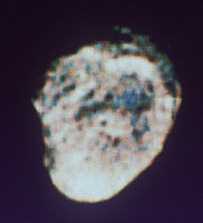Saturn's one large moon, Titan, and several of the ringed planet's medium-sized moons. Earth's Moon is also shown for size comparison.
Click on image for full size
Original Windows to the Universe artwork by Randy Russell using images courtesy NASA.
Large and Medium-sized Moons of Saturn
Saturn has
moons. Many of those are tiny chunks of rock or ice only a few kilometers (miles)
across. One of Saturn's moons, Titan,
is much larger than the rest and
is amongst the largest moons in our entire
Solar System.
Midway in size between Titan and the many tiny moonlets are several medium-sized
moons. The image on this page shows Titan and the mid-sized moons of Saturn.
They are, in order from largest to smallest: Rhea, Iapetus, Dione, Tethys, Enceladus, Mimas and Hyperion. Two more moons, Phoebe and Janus, are visible in the larger version of this image (click on the small image on this page to see the larger image).
The picture also shows Earth's Moon for
size comparison.
You might also be interested in:

Titan is the largest moon of Saturn, and the second largest moon in the entire Solar System (Jupiter's moon Ganymede is the largest). Titan's diameter is 5,150 km (3,200 miles), which is comparable to
...more
This is an image of the Earth's moon, shown in the center, with several other moons for comparison. The image shows that the Earth's moon is a lot smaller than Ganymede, Callisto, and Titan. The Earth's
...more
Rhea was discovered by G. Cassini in 1672. Rhea is the 5th farthest moon from Saturn, with a standoff distance of 527,040 km. It is one of the icy moons, similar to the Galilean satellites. Rhea is about
...more
Dione was discovered by G. Cassini in 1684. Dione is the 7th farthest moon from Saturn, with a standoff distance of 377,400 km. It is a small icy moon, lightly cratered, with wispy white streaks across
...more
Tethys was discovered by G. Cassini in 1684. Tethys is the 8th closest moon to Saturn, with a standoff distance of 294,660 km. It is one of the icy moons, similar to the Galilean satellites. Tethys is
...more
Enceladus is the sixth largest moon of Saturn. It was discovered in 1789 by the British astronomer William Herschel (who also discovered the planet Uranus). Enceladus is a medium-sized moon made primarily
...more
Hyperion was discovered by W. Bond in 1848. Hyperion is the 3rd farthest moon from Saturn, with a standoff distance of 1,481,000 km. Hyperion is 175 x 100 km (117 x 67 miles) in size. Its dimensions make
...more
Saturn has // Call the moon count function defined in the document head print_moon_count('saturn'); moons and a complex ring system. The moon Titan is one of the few moons in the solar system with a significant
...more














